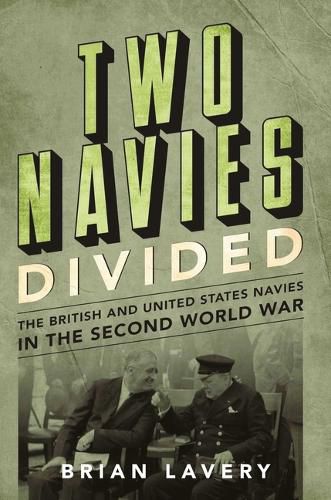Readings Newsletter
Become a Readings Member to make your shopping experience even easier.
Sign in or sign up for free!
You’re not far away from qualifying for FREE standard shipping within Australia
You’ve qualified for FREE standard shipping within Australia
The cart is loading…






The title is derived from George Bernard Shaw's comment that "England and America are two countries divided by a common language." It is not intended to imply that the two navies were seriously at odds with one another, but rather to suggest, as in the case of language, that common roots and usages varied significantly. And World War II is a pertinent moment for comparison. They fought on the same side against a common enemy for nearly four years, but Britain fought the war for the survival of itself and its empire, though in the long term it failed with the latter, while the American government fought to maintain its influence through the balance of power; its people fought for revenge for Pearl Harbor, and out of a sense of justice. In this new book, Brian Lavery describes and analyzes the differences and similarities between the two navies and in doing so sheds fascinating light on how the naval war was fought. For example, both navies had spectacular failures after entering the war -the Royal Navy off Norway, the U.S. Navy at Pearl Harbor and Savo Island. Paradoxically, both commenced the war with quite amateur performances by professional navies and ended with highly skilled performances by largely amateur manned forces. The training systems for regular officers had flaws in both countries. In Britain, entry was largely dependent on family income, in America, on political influence. But American officers probably had a broader perspective by the time they entered active service. The book covers ships and weapons systems--for instance, the British used too many gun types in the 4 to 6 inch range, while the Americans concentrated on the well-designed 5 inch--and the author describes conditions onboard ships. British vessels were awash with alcohol, which had its attractions for Americans when alongside; the Americans offered ice cream in return.
These examples represent only a tiny proportion of the subjects covered in this stimulating analysis. Aviation, the marines of both navies, anti-submarine and mine warfare, uniforms, propulsion systems, shipbuilding and building programs, commanders and national leaders, ratings and officers, ship design, geographical environments, naval bases, hammocks and bunks, the deployment of women -these are among the myriad big and small themes that will open the eyes of naval historians and enthusiasts, and show anyone with an interest in World War II how these two great allies came together to defeat the Axis forces.
$9.00 standard shipping within Australia
FREE standard shipping within Australia for orders over $100.00
Express & International shipping calculated at checkout
The title is derived from George Bernard Shaw's comment that "England and America are two countries divided by a common language." It is not intended to imply that the two navies were seriously at odds with one another, but rather to suggest, as in the case of language, that common roots and usages varied significantly. And World War II is a pertinent moment for comparison. They fought on the same side against a common enemy for nearly four years, but Britain fought the war for the survival of itself and its empire, though in the long term it failed with the latter, while the American government fought to maintain its influence through the balance of power; its people fought for revenge for Pearl Harbor, and out of a sense of justice. In this new book, Brian Lavery describes and analyzes the differences and similarities between the two navies and in doing so sheds fascinating light on how the naval war was fought. For example, both navies had spectacular failures after entering the war -the Royal Navy off Norway, the U.S. Navy at Pearl Harbor and Savo Island. Paradoxically, both commenced the war with quite amateur performances by professional navies and ended with highly skilled performances by largely amateur manned forces. The training systems for regular officers had flaws in both countries. In Britain, entry was largely dependent on family income, in America, on political influence. But American officers probably had a broader perspective by the time they entered active service. The book covers ships and weapons systems--for instance, the British used too many gun types in the 4 to 6 inch range, while the Americans concentrated on the well-designed 5 inch--and the author describes conditions onboard ships. British vessels were awash with alcohol, which had its attractions for Americans when alongside; the Americans offered ice cream in return.
These examples represent only a tiny proportion of the subjects covered in this stimulating analysis. Aviation, the marines of both navies, anti-submarine and mine warfare, uniforms, propulsion systems, shipbuilding and building programs, commanders and national leaders, ratings and officers, ship design, geographical environments, naval bases, hammocks and bunks, the deployment of women -these are among the myriad big and small themes that will open the eyes of naval historians and enthusiasts, and show anyone with an interest in World War II how these two great allies came together to defeat the Axis forces.